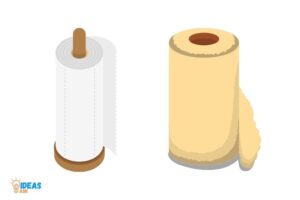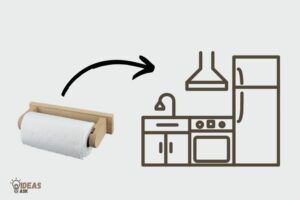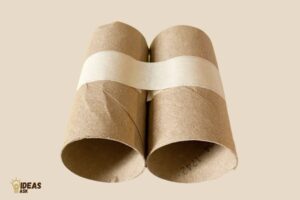Diy Tri Fold Paper Towel Dispenser
A diy tri-fold paper towel dispenser is a simple and cost-effective solution for organizing and storing paper towels. With just a few materials and tools, you can create a practical and useful accessory for your kitchen or workplace.
If you’re tired of the hassle and mess of multiple loose paper towel rolls cluttering your counter or workstation, a diy tri-fold paper towel dispenser may be just what you need. By taking advantage of basic crafting skills and affordable materials, you can create a customized and functional dispenser that matches your space’s decor and style.
In this article, we’ll provide step-by-step instructions for building your dispenser, along with tips for personalizing your creation and troubleshooting common issues. Whether you’re an experienced diy enthusiast or a beginner looking to start a new project, our guide is the perfect starting point for creating a practical and satisfying home accessory.
What Is A Tri-Fold Paper Towel Dispenser?
A tri-fold paper towel dispenser is a must-have in any kitchen or bathroom. It holds paper towels neatly and presentably, making them easily accessible when needed. A tri-fold paper towel dispenser has a distinct design that allows paper towels to be smoothly dispensed one at a time.
In this blog post, we will go over the definition and purpose of a tri-fold paper towel dispenser, the types of paper towel dispensers, and the advantages of making your own paper towel dispenser.
Definition And Purpose Of A Tri-Fold Paper Towel Dispenser
A tri-fold paper towel dispenser is a paper towel holder that dispenses one towel at a time, preventing more than one towel from being pulled at a time. It has a spacious design that accommodates multiple folds of paper towels, preventing the stack from falling over.
The dispenser comes with a cover that keeps the towels clean and hygienic. A tri-fold paper towel dispenser is a great addition to any restaurant or home as it keeps the area clean and organized.
Types Of Paper Towel Dispensers And Their Uses
Paper towel dispensers come in various styles, and each has its own unique use. Understanding the differences between dispensers can help you choose the best one for your needs. Here are the most common types of paper towel dispensers and their uses:
- Single fold: One towel is dispensed per pull. This type of dispenser is common in public restrooms.
- C-fold: A fan-folded towel is dispensed, and another towel pops up once one is removed. This type of dispenser often comes in a countertop or wall-mounted dispenser.
- Multifold: A stack of towels is dispensed and one towel pops up once one is removed. This type of dispenser is common in busy restrooms or kitchens.
- Roll towel: A paper towel roll is pulled and cut using a lever, causing a new towel to emerge after each use. This type of dispenser is common in kitchens or home settings.
Advantages Of Making Your Own Paper Towel Dispenser
Making a diy paper towel dispenser can save money and add a unique touch to your home or business. It allows you to customize the dispenser’s look, size, and functionality to fit your needs. Here are some benefits of making your own paper towel dispenser:
- Cost-effective: Making your own dispenser is cheaper than buying one.
- Customizable: You can tailor the design to your needs, such as adjusting the size or shape.
- Environmentally friendly: You can use recycled materials to make the dispenser, reducing waste.
- Fun project: Making your own dispenser is a fun diy project that can be done alone or with friends or family.
A tri-fold paper towel dispenser is an essential item for any kitchen or bathroom. Understanding the purpose of a tri-fold paper towel dispenser, the different types of paper towel dispensers and their uses, and the advantages of making your own dispenser can help you choose the best one for your needs.
Materials And Tools Required
Detailed List Of Materials And Tools Needed For The Diy Project
To make your diy tri-fold paper towel dispenser, you will need the following materials and tools:
Materials
- Wooden board (size: 18” x 24” x 1”)
- Plywood (size: 6” x 18” x 1”)
- Sandpaper (grit 120 and 220)
- Wood glue
- Varnish
- Paper towel holder mechanism
- Screws (size: #6 x 1”)
- Small screws (size: #4 x 1/2”)
- Wood filler
- Paintbrush
- Painter’s tape
Tools
- Table saw
- Circular saw
- Jigsaw
- Power drill
- Drill bits (size: 3/16” and 1/8”)
- Clamps
- Square ruler
- Measuring tape
- Pencil
- Safety glasses
- Ear protection
Descriptions And Pictures Of Each Material And Tool
Materials
- Wooden board (size: 18” x 24” x 1”): this will serve as the main part of your paper towel dispenser. The size may vary, but you want to make sure it’s thick enough to hold everything in place.

- Plywood (size: 6” x 18” x 1”): you will use this to create the top and bottom of your dispenser. Sand it smooth for a clean finish.

- Sandpaper (grit 120 and 220): To get a clean and smooth finish, you will need sandpaper of different grits. 120 grit will help remove any roughness, while 220 grit will give it a polished look.

- Wood glue: This will be used to secure the plywood to the wooden board.

- Varnish: A coat of varnish helps protect the wood from dust and stains, giving it a glossy finish.

- Paper towel holder mechanism: This will hold your paper towels in place. You can find one at any hardware store.

- Screws (size: #6 x 1”): these are used to attach the paper towel holder mechanism to the wooden board.

- Small screws (size: #4 x 1/2”): these will be used to attach the plywood to the wooden board.

- Wood filler: Fill any cracks or gaps in the wood with wood filler for a seamless finish.

- Paintbrush: You will use this to apply the varnish.

- Painter’s tape: Use this to protect areas you don’t want varnished, such as the paper towel holder mechanism.

Tools
- Table saw: Used to cut the wooden board to the desired size.

- Circular saw: Used to cut the plywood to size.

- Jigsaw: Use it to cut out the hole for the paper towel holder mechanism.

- Power drill: You will use this to make pilot holes for the screws.

- Drill bits (size: 3/16” and 1/8”): you will use these to make the pilot holes.

- Clamps: Use them to secure the plywood to the wooden board and hold them in place while the glue dries.

- Square ruler: Helps you measure and mark correct angles and distances.

- Measuring tape: Used to measure the dimensions of your materials and make accurate cuts.

- Pencil: Used to mark the dimensions of your materials before cutting them.

- Safety glasses: Always wear protective eyewear when using power tools to avoid any accidental damage to your sight.

- Ear protection: Using circular saw and power drill can be loud, protect eardrums with earmuffs to avoid tinnitus and hearing loss.

With all the necessary materials and tools in your hands, you’re ready to start assembling your diy tri-fold paper towel dispenser. Let’s proceed to the building instructions.
Step-By-Step Instructions On Building A Diy Tri-Fold Paper Towel Dispenser
Detailed Guide On Building The Dispenser
Building a diy tri-fold paper towel dispenser doesn’t have to be a challenge. With a few basic tools and some woodworking skills, you can create a functional and stylish dispenser that will make your life a lot easier. Here is a detailed guide to building a diy tri-fold paper towel dispenser:
- Gather all the necessary tools and materials before you start. You will need a saw, a drill, sandpaper, glue, screws, and a measuring tape, as well as wood of your choice.
- Measure and cut the pieces for the dispenser. You will need four pieces of wood for the base, front, back, and top of the dispenser. The dimensions will depend on the size of the paper towels you plan to use.
- Assemble the base of the dispenser by attaching the front and back pieces of wood to the sides using screws and glue. Sand the edges to make the pieces as smooth as possible.
- Drill holes in the top piece of wood to allow for the dowels to fit through. Make sure the holes are spaced evenly to accommodate the paper towels.
- Attach the top piece of wood to the base of the dispenser using screws and glue, making sure that it is level and secure.
- Insert the dowels into the holes in the top piece of wood, making sure that they are level and secure. The paper towels should be able to slide over the dowels easily.
- Mount the dispenser to the wall using screws and anchors. Make sure that it is level and secure.
With these simple steps, you can create a functional and stylish diy tri-fold paper towel dispenser that will make your life a lot easier.
Tips And Tricks To Make The Process Easier
While building a diy tri-fold paper towel dispenser may seem daunting, a few tips and tricks can make the process much easier. Here are some tips and tricks to keep in mind:
- Choose the right wood for your project. Softwoods, such as pine, are easier to work with than hardwoods and are more affordable.
- Use a saw blade with a higher number of teeth to create a smoother cut.
- Sand the wood before assembly to create a smoother finish and avoid splinters.
- Apply wood glue to the edges of the pieces before attaching them to ensure a stronger bond.
- Use a level to ensure that the dispenser is straight and level before mounting it to the wall.
- Use a drill bit that is slightly smaller than the dowels to create a tight fit.
- If you plan to stain or paint the dispenser, ensure that you do so before attaching the top piece of wood to the base.
Keeping these tips and tricks in mind can make the process of building a diy tri-fold paper towel dispenser much easier and less intimidating.
Overall, building a diy tri-fold paper towel dispenser is a fun and practical project that can be completed with just a few basic tools and some woodworking skills. With clear and concise instructions and some helpful tips and tricks, you can create a stylish and functional dispenser that will make your life a lot easier.
Decorative Options And Customizations
Diy tri fold paper towel dispenser is a perfect addition to your kitchen space. You can decorate and customize it to fit your style and taste. Here are some suggestions:
Suggestions On How To Decorate And Customize The Dispenser To Fit Your Taste And Style
- Choose the right color: You can use a color that matches the decor of your kitchen or select a contrasting one to make the dispenser stand out.
- Use patterns: You can add patterns such as stripes, polka dots, or chevron with paint or stickers to create a unique design.
- Add stickers: Decorative stickers are an inexpensive way to add a personal touch to your dispenser. You can use stickers that match your kitchen decor, or opt for fun and quirky designs.
Tips On Using Different Colors, Patterns, And Materials
- Choose durable materials: Consider using materials that are water-resistant and easy to clean, such as acrylic or plastic. This will ensure the longevity of your dispenser.
- Use spray paint: Spray paint is an easy and quick option for transforming your dispenser’s look. Make sure that you cover the entire dispenser evenly.
- Mix and match colors and patterns: You can create a unique design by mixing and matching colors and patterns. For example, if you choose a bright color for the base, you can add a subtle design with stickers or paint.
Step-By-Step Instructions On How To Paint Or Decorate Your Dispenser
- Clean the dispenser: Make sure the dispenser is clean and dry before beginning the decoration process. Use soap and water to clean off any dirt or residue.
- Sand the dispenser: Lightly sand the dispenser to prepare it for painting. This will help the paint adhere better to the surface.
- Apply primer: Apply a generous coat of primer to the dispenser and let it dry completely.
- Paint the dispenser: Once the primer has dried, apply the paint to the dispenser. You can use a brush or spray paint, just make sure that you cover the entire dispenser evenly.
- Add stickers: If you want to add stickers, wait until the paint has dried and then stick them to the dispenser.
- Finish with a sealant: Once you are happy with the design of the dispenser, apply a sealant to protect the paint and stickers.
There you have it – easy steps to decorating and customizing your own diy paper towel dispenser! With these tips, you can create a unique and functional addition to your kitchen that reflects your style and taste.
Frequently Asked Questions For Diy Tri Fold Paper Towel Dispenser
How To Make A Diy Tri-Fold Paper Towel Dispenser?
To make a diy tri-fold paper towel dispenser, you will need cardboard, a cutting tool, and a ruler. First, measure and cut the cardboard into the desired shape. Then, create the folds and add slots for the paper towels. Finally, decorate and enjoy!
Why Use A Diy Tri-Fold Paper Towel Dispenser?
Using a diy tri-fold paper towel dispenser is a great way to save money and reduce waste. It allows you to control the amount of paper towels you use, making them last longer. Plus, it’s a fun and easy diy project!
Can I Customize My Diy Tri-Fold Paper Towel Dispenser?
Absolutely! You can customize your diy tri-fold paper towel dispenser with paint, stickers, or any other decorations you like. You can also adjust the measurements to fit your specific paper towel size.
Is It Difficult To Use A Diy Tri-Fold Paper Towel Dispenser?
Using a diy tri-fold paper towel dispenser is very easy and intuitive. Simply pull out a paper towel from the slot, and tear it off as normal. The dispenser will keep the rest of the paper towels neatly organized and easy to access.
Conclusion
So there you have it, your very own diy tri fold paper towel dispenser that is not only space-saving but also convenient and attractive. With just a few easy-to-find materials and simple steps, you can have a functional and stylish paper towel holder that suits your needs.
Not only is this project a great way to save money on buying pre-made dispensers, but it also provides an opportunity to personalize your home with your unique style. With the added bonus of being environmentally friendly, using less materials and foregoing plastic packaging.
You can customize this dispenser to fit the color scheme of your kitchen or even add some personal flair with stencils or designs. With a little bit of creativity and craftsmanship, you can enhance the aesthetics of your home in a practical and eco-friendly way.





